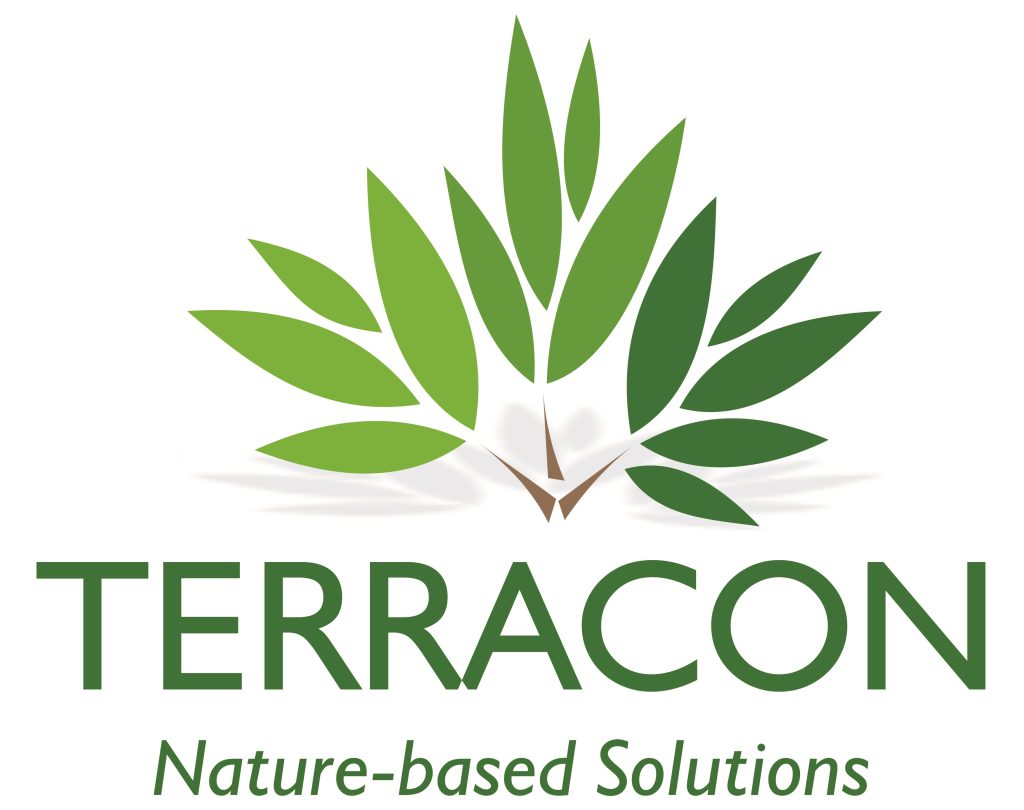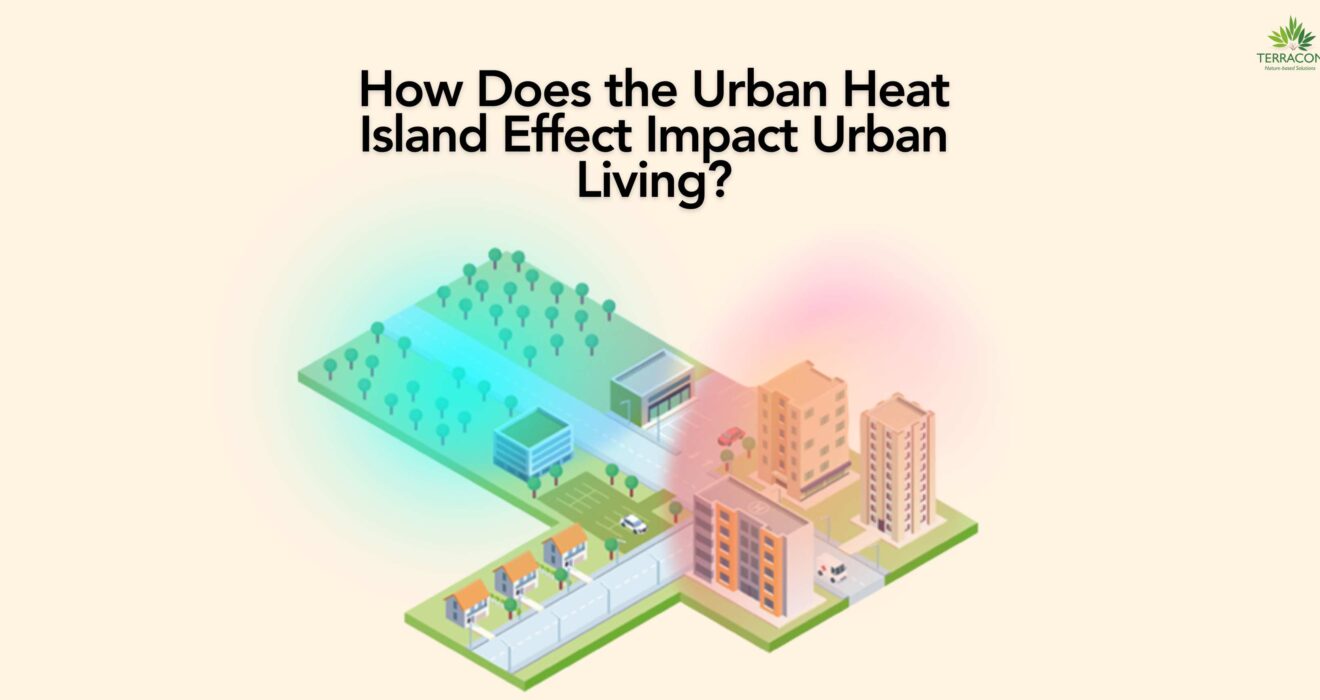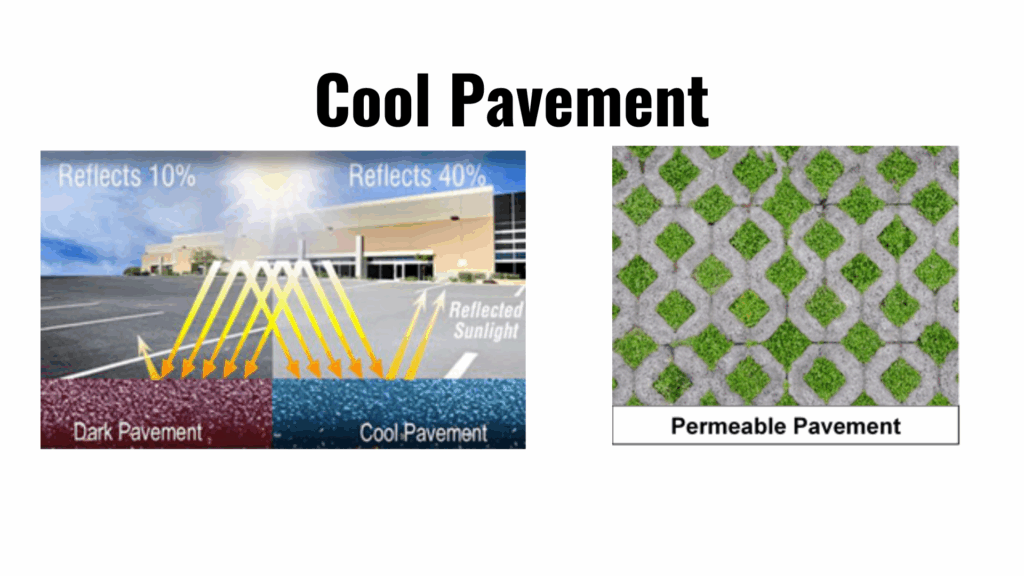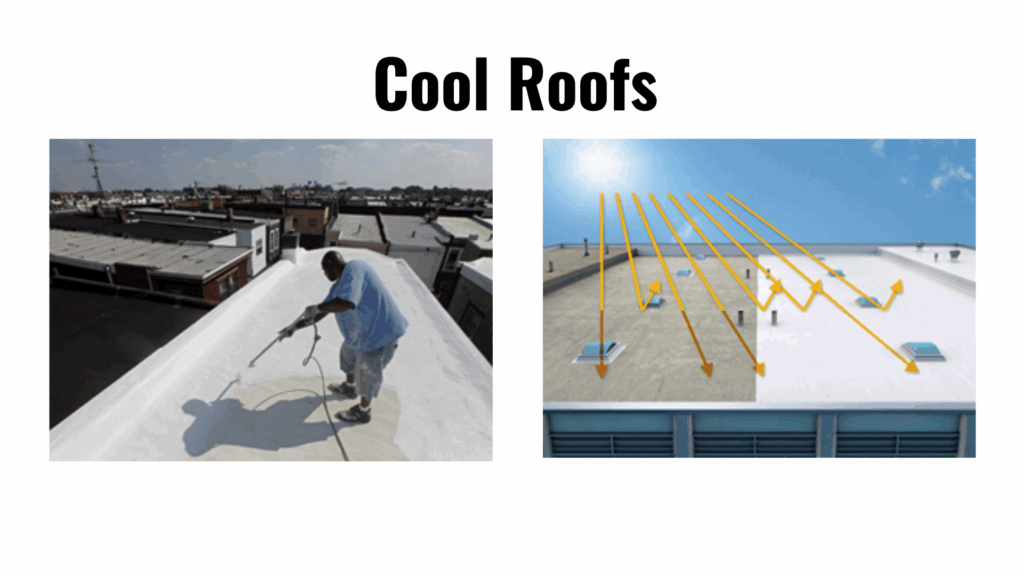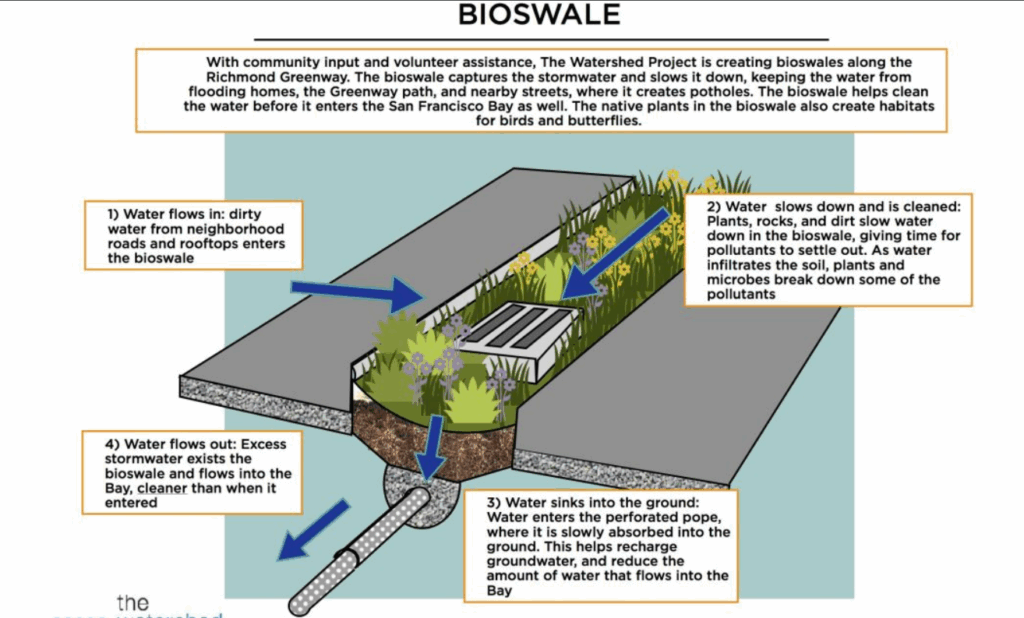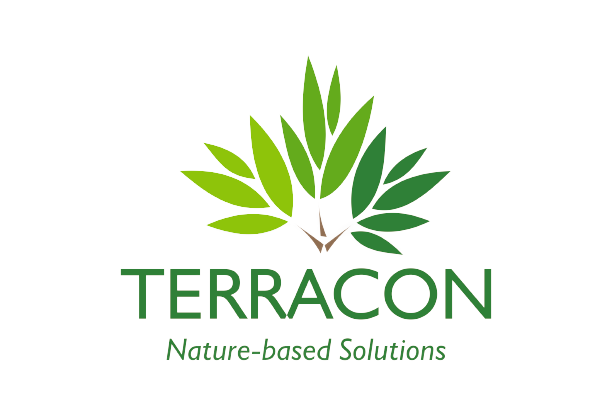Urban areas today are heating up faster than ever. The dense concrete, limited green cover, and constant human activity trap heat and create zones significantly warmer than nearby rural areas.
This phenomenon is known as the Urban Heat Island (UHI) effect — and it’s more than just discomfort. It impacts public health, increases energy demand, and worsens air pollution.
Understanding UHI is the first step toward building cities that are not just modern — but also cooler, greener, and healthier.
The Urban Heat Island Phenomenon
The concept of UHI isn’t new. Luke Howard, a British meteorologist, made the first observation of UHI in 1810. The term was later coined by German meteorologist Albert Peppler in 1929. UHIs have been divided into two primary categories:
1. Surface Urban Heat Island (SUHI):
When land surface temperatures in urban areas are greater than those in nearby rural regions, this phenomenon is known as a Surface Urban Heat Island (SUHI). SUHIs are typically most obvious during the day, as solar radiation directly heats urban surfaces like rooftops and pavements. We primarily measure SUHIs using thermal satellite imaging, Geographic Information Systems (GIS), and remote sensing technologies.
2. Atmospheric Urban Heat Island (AUHI):
In contrast, AUHIs describe the phenomenon of elevated air temperatures within urban areas compared to their rural surroundings. These are usually measured using weather stations and mobile sensors and can be further categorized into boundary- and canopy-layer urban heat islands.
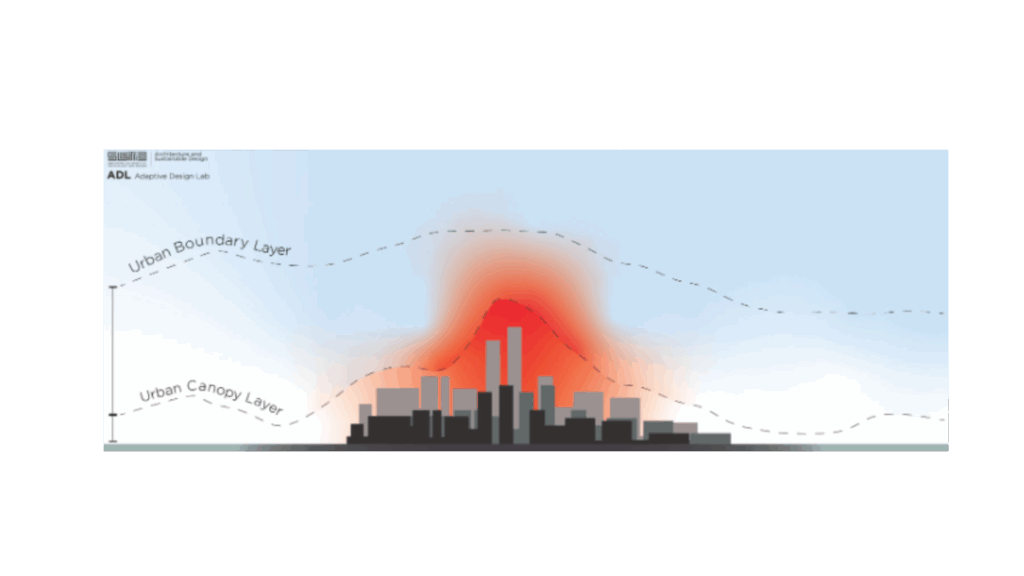
What Fuels the Urban Heat Island Effect?
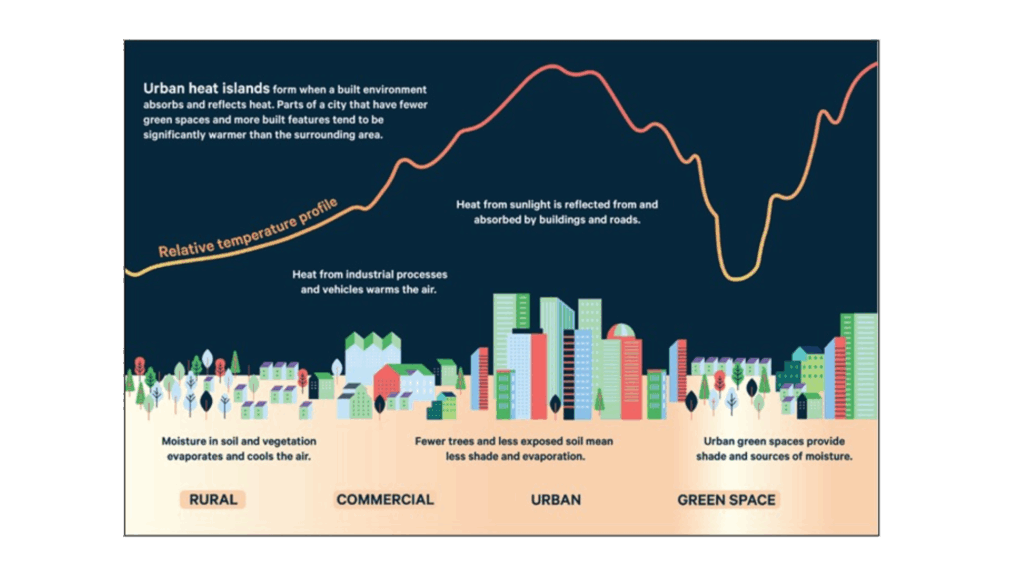
1. Land Cover and Surface Materials:
A primary driver of UHIs is the extensive use of impermeable surfaces in urban areas. Materials like concrete and asphalt, commonly found in roads, buildings, and parking lots, replace natural vegetation and soil. Unlike natural environments, these materials absorb and retain significantly more heat, leading to warmer urban environments.
2. Urban Geometry and Canyon Effect:
The way cities are built also plays a crucial role. Tall buildings and narrow streets create what’s known as the ‘urban canyon effect’. In these urban canyons, vertical building surfaces trap and reflect solar radiation, limiting the escape of heat into the atmosphere and intensifying the UHI effect. This geometry also restricts wind flow, further hindering natural cooling.
3. Anthropogenic Heat Emissions:
Cities are hubs of human activity, and the energy consumption from transportation, industries, and buildings contributes substantially to the UHI effect. Heat emitted directly from vehicles, air conditioners, and industrial processes elevates the ambient temperature within urban areas.
4. Reduced Vegetation:
Plants and trees help lower air temperatures by releasing water vapor into the atmosphere through evapotranspiration. The absence of greenery in cities significantly worsens the urban heat island effect by decreasing this natural cooling process, which involves the transfer of water from the land surface to the air via plant transpiration and soil evaporation.
Effects
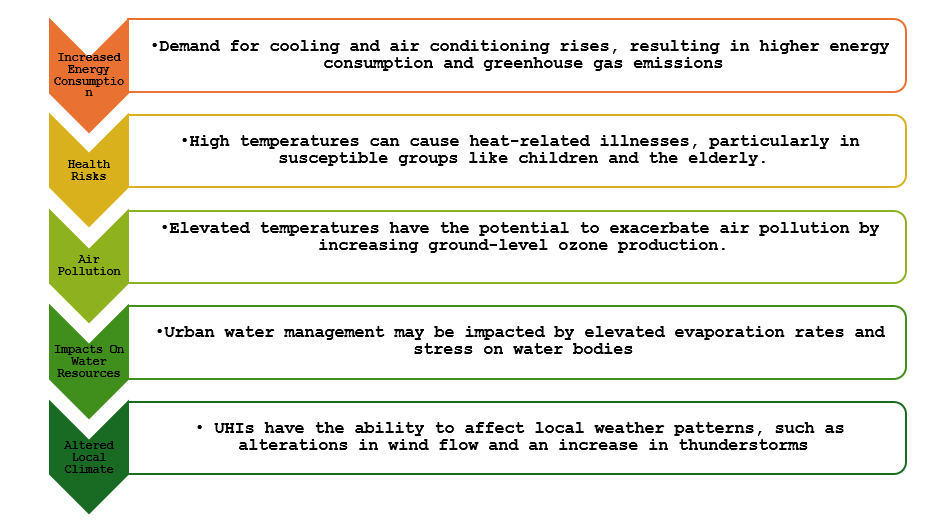
Mitigating the Heat: Strategies for Cooler Cities
1. Urban Forestry and Green Spaces:
Planting and maintaining trees within urban areas (urban forestry), creating parks, street trees, and green roofs are vital. Trees and plants provide shade, lower surface and air temperatures through evapotranspiration, and improve air quality. These green spaces act as essential ‘cooling islands’ amidst concrete-dominated areas, significantly reducing local temperatures. Beyond cooling, they enhance biodiversity, offer recreational opportunities, and boost residents’ mental well-being. Successful implementation involves selecting appropriate tree species, developing green corridors, and integrating vegetation into all urban development plans.
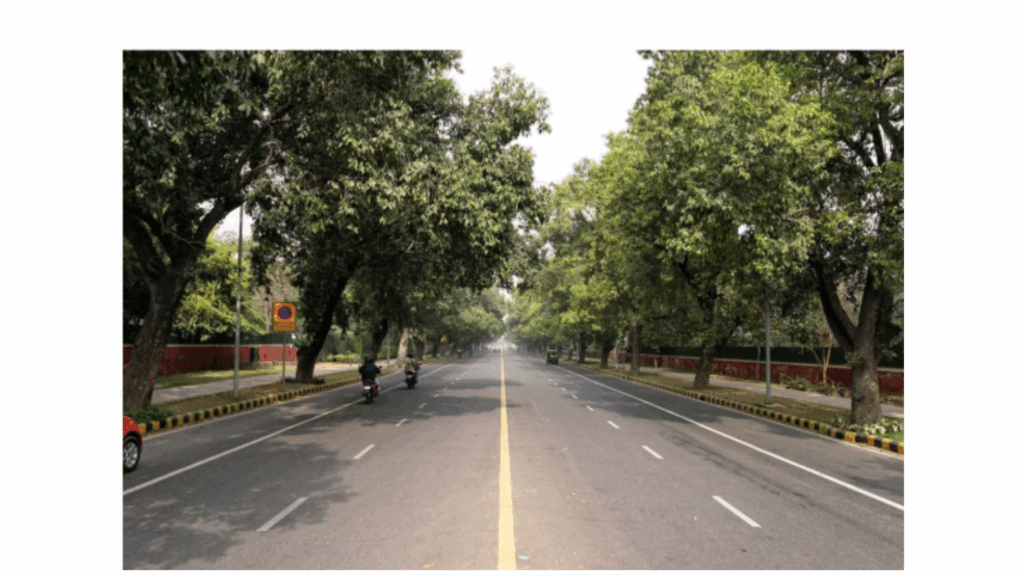
2. Cool Roofs and Pavements
This strategy involves using materials that reflect more sunlight and absorb less heat than conventional surfaces. To lower internal and outdoor temperatures, cool roofs might use reflective coatings, specialised tiles, or membranes. Cool pavements utilize high-albedo (high-reflectivity) materials like light-coloured concrete, asphalt with reflective coatings, or permeable pavements that reflect solar radiation and facilitate heat dissipation. These measures effectively lower surface temperatures, reduce heat transfer into buildings, and decrease overall urban temperatures. They are also affordable and appropriate for extensive uses.
3. Green Infrastructure and Stormwater Management:
Green infrastructure integrates natural systems such as permeable pavements, rain gardens, bioswales, green roofs, and vegetated detention basins to manage stormwater sustainably. These features reduce surface runoff, filter pollutants, and promote evapotranspiration, which cools the environment. By controlling water flow and increasing vegetation, green infrastructure minimizes urban heat retention, mitigates flood risks, and enhances urban resilience to climate change. Proper planning ensures these features are seamlessly integrated into urban landscapes to maximize their cooling benefits.
4. Urban Planning and Design:
Thoughtful urban planning involves designing cities with climate resilience as a core principle. This includes strategically orienting buildings to maximize shading, creating wind corridors for natural ventilation, and designing street layouts that promote airflow. Incorporating compact urban forms with high-density development can reduce sprawling areas that exacerbate UHI effects. Zoning policies can encourage green building standards, mixed-use developments, and the preservation of natural landscapes. These urban design solutions aim to limit heat absorption and improve natural cooling processes, leading to more pleasant and sustainable urban settings.
5. Public Awareness and Policy Interventions:
Raising public awareness about the UHI effect is crucial for fostering community participation in mitigation efforts. Educational campaigns can highlight the benefits of green spaces, sustainable building practices, and water conservation. Policy interventions include establishing regulations and incentives for green building codes, urban greening projects, and the adoption of cool roofs and pavements. Governments can implement zoning laws, provide subsidies, and develop comprehensive urban heat action plans to support mitigation strategies. Robust policies coupled with active public participation are essential for the broad adoption and effectiveness of UHI mitigation initiatives.
Benefits
1. Reduced Energy Use:
Mitigating the UHI effect reduces urban temperatures, lowering reliance on air conditioning and decreasing energy consumption. This leads to lower utility bills, less strain on power grids, and reduced fossil fuel use, promoting sustainability.
2. Reduced Air Pollution and Greenhouse Gas Emissions:
Cooler urban areas with green spaces and reflective surfaces reduce heat, pollutants, and reliance on fossil fuel-powered air conditioning, improving air quality. These strategies lower greenhouse gas emissions, helping combat climate change and create healthier cities.
3. Carbon Storage and Sequestration:
Urban vegetation like trees and green roofs absorb CO2, acting as natural carbon sinks that help combat climate change. Promoting green infrastructure enhances carbon sequestration, supporting sustainable cities and offsetting emissions.
4. Enhanced Quality of Life:
Mitigating the urban heat island effect improves health, reduces stress, and enhances quality of life by providing cooler, greener spaces. These areas also boost air quality, lower noise, and promote well-being for city residents.
5. Enhanced Stormwater Management and Water Quality:
Green infrastructure improves stormwater management by reducing flooding, filtering pollutants, and easing sewer system loads. It also protects water quality and aquatic ecosystems, benefiting urban residents.
References :
What are other benefits of green infrastructure?
A Study on Urban Heat Island (UHI): Challenges and Opportunities for Mitigation

Written By
SWARA RANE
Team Terracon Ecotech
